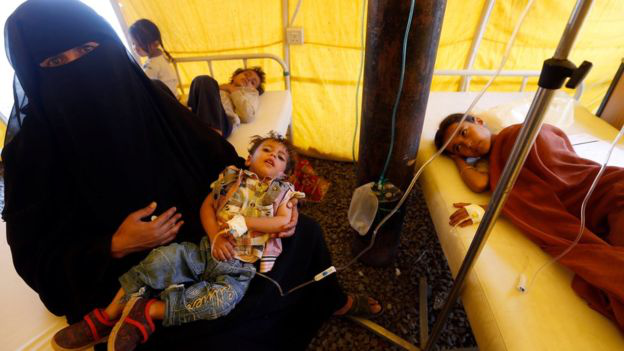
The number of suspected cases of cholera resulting from a severe outbreak in Yemen has passed 100,000, the World Health Organization says. A total of 798 deaths associated with the disease have been recorded in 19 out of 22 provinces since 27 April. The charity Oxfam said the disease was killing one person almost every hour. Yemen's health, water and heath systems are collapsing after two years of war between government forces and the rebel Houthi movement.
Cholera is an acute infection caused by food or water contaminated with the bacterium Vibrio cholera. Most of those infected will have no or mild symptoms but, in severe cases, the disease can kill within hours if left untreated. In the past four weeks the number of deaths had been three times higher than that reported between October 2016—when Yemen's government first announced an outbreak —and March 2017.
The authorities in the rebel-controlled capital Sanaa, which has recorded the highest number of cases, declared a state of emergency on 14 May. More than half of the country's hospitals are no longer functioning, with almost 300 having been damaged or destroyed in the fighting. Health workers have not been paid for eight months; only 30% of required medical supplies are being imported into the country; rubbish collection in the cities is irregular; and more than 8 million people lack access to safe drinking water. The OCHA said the risk of the spreading further was increased by the rainy season, widespread food insecurity and malnutrition.
Oxfam's Yemen country director, Sajjad Mohammed, warned that the outbreak was set to be one of the worst this century if there was not an immediate effort to bring it under control. "Cholera is simple to treat and prevent, but the fighting made it doubly difficult. " he said. "People need to put pressure on parties to the fighting to agree a ceasefire at first to allow public health and aid workers to get on with the task."
本时文内容由奇速英语国际教育研究院原创编写,未经书面授权,禁止复制和任何商业用途,版权所有,侵权必究!(投稿及合作联系:028-84400718 QQ:757722345)
1.What made the cholera spread?
A The water or food polluted by the bacterium Vibrio cholera.
B The food that made from the rebel Houthi movement.
C The systems that are collapsing after two years of war.
D The lack of help from the World Health Organization.
解析:选A。细节理解题。根据第二段第一句的Cholera is an acute infection caused by food or water contaminated with the bacterium Vibrio cholera可以得知污染了的水和食物会传播霍乱。故选A。
2.When did Yemen’s capital Sanaa declare its state of emergency facing cholera?
A On 27 March.
B On 12 October.
C On 14 May.
D On 20 March.
解析:选C。细节理解题。根据第三段第一句的The authorities in the rebel-controlled capital Sanaa, which has recorded the highest number of cases, declared a state of emergency on 14 May可以得知也门的首都是在5月14日宣布进入紧急状态的。故选C。
3.Why did the cholera cause so many people to die?
A Because cholera was hard to treat and prevent.
B Because the country collected the rubbish fast.
C Because the country lacked a lot of rain now.
D Because they were not treated properly then.
解析:选D。推理判断题。根据第三段第二、三句的More than half of the country's hospitals are no longer functioning, with almost 300 having been damaged or destroyed in the fighting. Health workers have not been paid for eight months; only 30% of required medical supplies are being imported into the country以及后面的Cholera is simple to treat and prevent, but the fighting made it doubly difficult.可以得知是由于战乱破坏了医院,造成医疗条件不好,那些患有霍乱的人没有得到很好的治疗,才导致那么多人死亡。故选D。
4.What is the best way to stop the disease from spreading in Yemen?
A People should give them medicine.
B The good food should be given to people.
C The fighting sides should stop the battle.
D Health workers should not have been paid.
解析:选C。细节理解题。根据文章最后一段最后一句的People need to put pressure on parties to the fighting to agree a ceasefire at first to allow public health and aid workers to get on with the task可以得知交战双方先停火是阻止这个疾病传播的最好的方法。故选C。